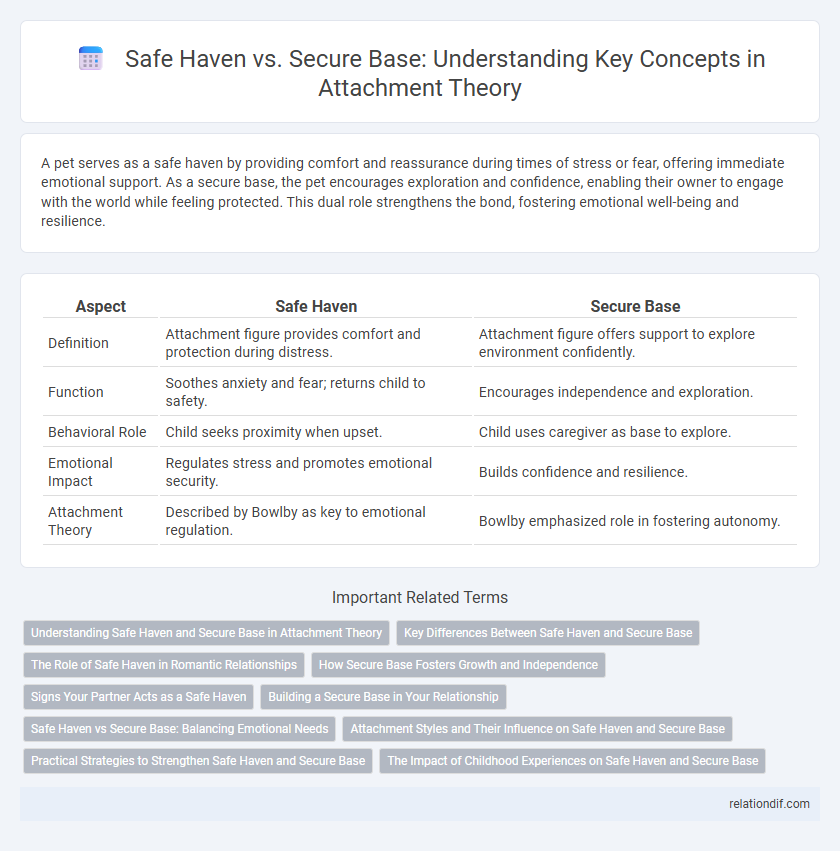A pet serves as a safe haven by providing comfort and reassurance during times of stress or fear, offering immediate emotional support. As a secure base, the pet encourages exploration and confidence, enabling their owner to engage with the world while feeling protected. This dual role strengthens the bond, fostering emotional well-being and resilience.
Table of Comparison
| Aspect | Safe Haven | Secure Base |
|---|---|---|
| Definition | Attachment figure provides comfort and protection during distress. | Attachment figure offers support to explore environment confidently. |
| Function | Soothes anxiety and fear; returns child to safety. | Encourages independence and exploration. |
| Behavioral Role | Child seeks proximity when upset. | Child uses caregiver as base to explore. |
| Emotional Impact | Regulates stress and promotes emotional security. | Builds confidence and resilience. |
| Attachment Theory | Described by Bowlby as key to emotional regulation. | Bowlby emphasized role in fostering autonomy. |
Understanding Safe Haven and Secure Base in Attachment Theory
Safe haven serves as an emotional refuge during distress, where the attachment figure provides comfort and alleviates fear, crucial for emotional regulation and stress relief. Secure base enables exploration and autonomy, allowing the individual to confidently engage with the environment knowing support is available if needed, fostering independence and growth. Both concepts are fundamental in attachment theory, explaining how secure relationships promote psychological resilience and healthy development.
Key Differences Between Safe Haven and Secure Base
Safe haven refers to a caregiver's responsiveness during times of distress, providing comfort and protection to soothe an individual's emotional needs. Secure base involves the caregiver's consistent support that encourages exploration and autonomy while maintaining a reliable presence. Key differences include safe haven focusing on immediate comfort during stress, whereas secure base emphasizes ongoing encouragement for growth and independence.
The Role of Safe Haven in Romantic Relationships
A safe haven in romantic relationships provides emotional refuge and comfort during times of stress or conflict, allowing partners to recover and regulate their emotions effectively. This secure emotional support fosters trust and resilience, strengthening the bond and promoting healthier communication between partners. Unlike a secure base, which encourages exploration and growth, the safe haven emphasizes immediate protection and soothing during vulnerability.
How Secure Base Fosters Growth and Independence
A secure base provides a reliable foundation from which individuals can explore their environment, fostering personal growth and independence by offering consistent emotional support and safety. It enables individuals to take risks and face challenges confidently, knowing they have a dependable source of comfort to return to when needed. This dynamic support mechanism is crucial for building resilience and self-efficacy in relationships and development.
Signs Your Partner Acts as a Safe Haven
Your partner acts as a safe haven when they provide comfort and support during times of stress, allowing you to express vulnerability without fear of judgment. They respond sensitively to your emotional needs, helping to soothe anxiety and restore a sense of calm. Consistent reassurance and a non-judgmental presence are key indicators that your partner serves as a reliable safe haven in the relationship.
Building a Secure Base in Your Relationship
Building a secure base in your relationship involves fostering consistent emotional availability and trust, allowing partners to explore and grow confidently. Safe haven provides comfort during distress, while a secure base empowers autonomy and resilience. Prioritizing open communication and empathetic support strengthens attachment bonds and promotes long-term relational security.
Safe Haven vs Secure Base: Balancing Emotional Needs
Safe haven provides immediate comfort and emotional support during times of distress, allowing individuals to feel protected and soothed. Secure base fosters exploration and growth by offering a reliable foundation of safety, encouraging confidence and independence. Balancing safe haven and secure base functions is essential for healthy attachment, ensuring emotional needs for both reassurance and autonomy are met.
Attachment Styles and Their Influence on Safe Haven and Secure Base
Attachment styles significantly influence how individuals perceive and utilize safe haven and secure base functions in relationships. Secure attachment fosters effective use of a partner as both a safe haven during stress and a secure base for exploration, promoting emotional regulation and confidence. In contrast, anxious or avoidant attachment styles may hinder individuals from fully accessing these roles, resulting in inconsistent or impaired support-seeking behaviors.
Practical Strategies to Strengthen Safe Haven and Secure Base
To strengthen safe haven and secure base functions in attachment relationships, prioritize consistent emotional availability and responsive caregiving to foster trust and security. Implement practical strategies such as active listening, validating feelings, and encouraging exploration with support, which promote a balance between comfort during distress and confidence in autonomy. Building rituals of reassurance, open communication, and reliable support enhances both emotional safety and developmental growth within relationships.
The Impact of Childhood Experiences on Safe Haven and Secure Base
Childhood experiences shape the development of safe haven and secure base functions within attachment relationships, influencing emotional regulation and exploration behaviors. Consistent caregiving fosters a dependable safe haven, providing comfort in distress, while a reliable secure base encourages independence and confidence in novel situations. Disruptions or inconsistencies in early attachment can impair these functions, leading to difficulties in managing stress and forming healthy relationships later in life.
Safe haven vs secure base Infographic

 relationdif.com
relationdif.com